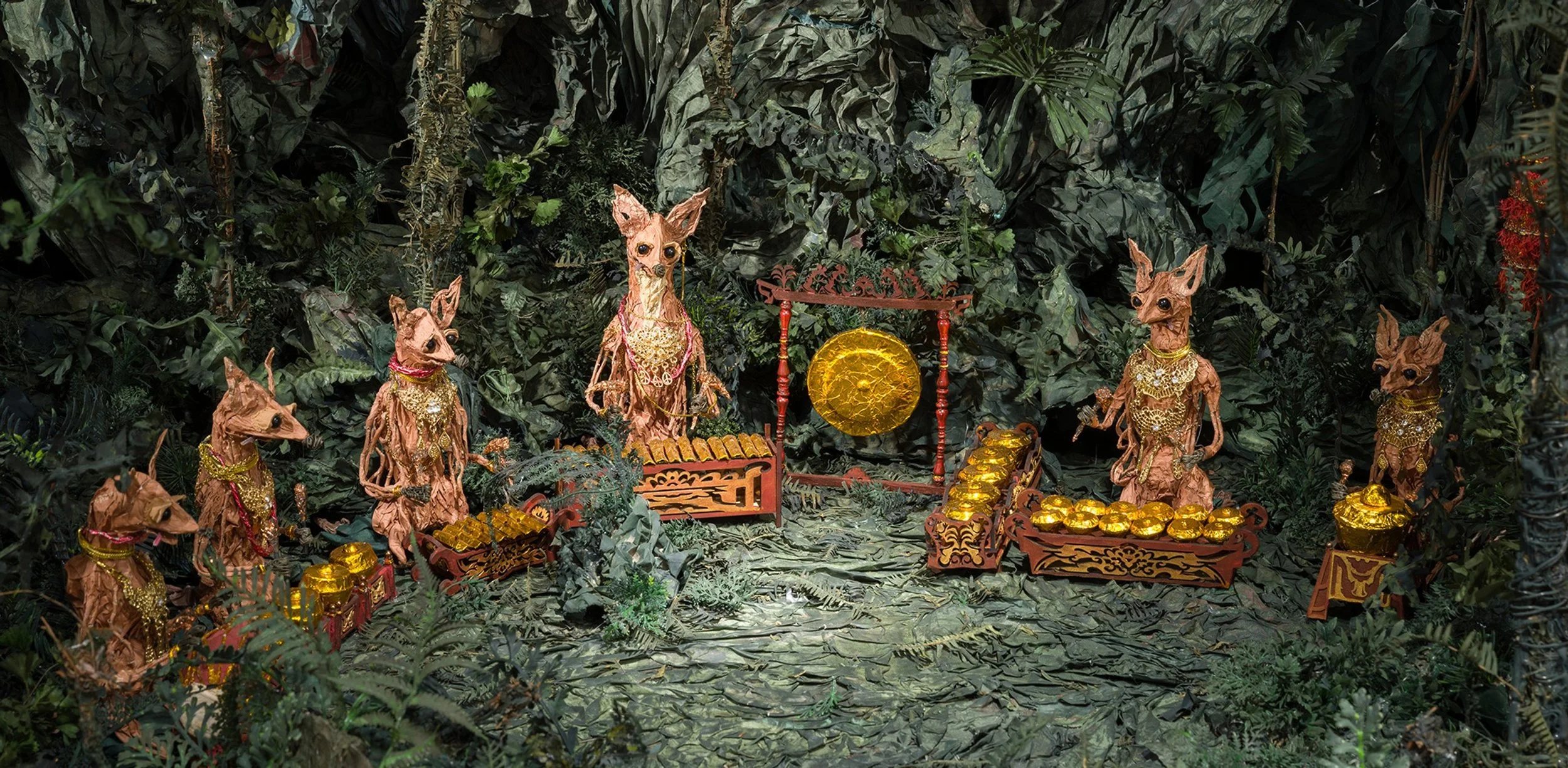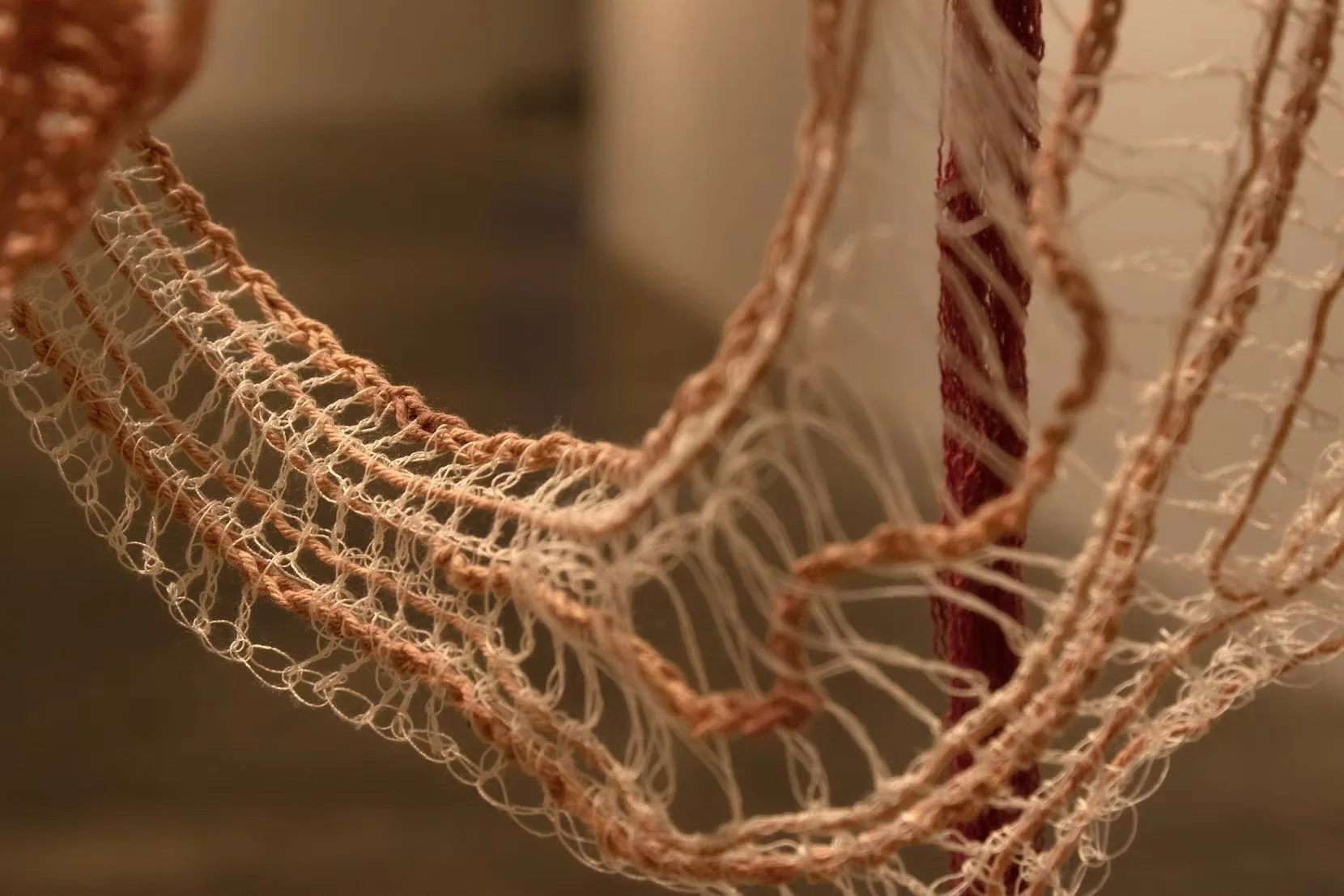Leaf 1
Gripping Newspapers and Mortal Threads
[Museum of International Folk Art: Lloyd’s Treasure Chest] and [Wheelwright Museum]
Site Santa Fe 2025 is a provocatively distributed performance. For six months, fourteen locations have been ingeniously selected to house original media pondering the puzzles of time. The draw of secretive architecture transforms the visitor’s hunt for exhibitions into mythic quests, and installations into enduring fairytales.
Consider the unremarkable elevator in the rear of the MIFA opening; not into anticipated steel cage, but into padded crypt of stained and pleated newspapers. Opening again, viewers enter a dark grotto alive with mysterious rattling, drum beats, whipping wings, tinkling glass: Taiwanese artist Zhang Xu Zhan’s “paper-skinned” stop-motion animations [from his Southeast Asian Animal-Stories.] Here, too, every surface but one is upholstered in twisted Chinese local dailies: deader -than- dead past editions.
If the tomb-like interior is un-individuated except for small sculptures— flammable offerings used in Taoist funeral ceremonies placed around a Spirit House—the single horizontal wall blazes with animated images. Composed of newsprint, fiber, foil, paint, plaster, riveting figures enact a gripping allegory of life and death on screen. Set within the forest primeval: a bejeweled beast-man [equipped with glittering feelers and tinsel legs] awakens and runs. Kneeling on the banks of a crystal lake, he drinks thirstily unaware of the red-tongued menace.
The perspective shifts abruptly from pursued to pursuer. The terrifying struggle – afloat of crocodiles roils the splintery cellophane - is amplified by distant drumming of mouse-deer and violent shaking of crimson tasselled prayer wheels. Compulsively, the human animal crosses and recrosses the crocodile bridge. Struggling ashore for the last time, he sheds limbs, jewels until only one torn arm and hand touch the earth. The mirror of glassy illusion [partially overlaid on the scenery from the start] fragments into a jagged shard pulled away by that symbol of transformation, a dragonfly. Wondrously capturing our heedless run though time, this elegiac Diorama seizes its fleetingness.
A stone’s throw down Camino Lejo, temporality is pictured by the run, that with time, runs through organic material. The Wheelright’s new Klah Gallery— significantly entered through a side, not main, door and designed as a Dine Hogan with timbered roof—presents a twilit interior suited to an art of evocative rudiments and elusive feelings.
Cristina Flores Pescoran’s narrow, cotton thread and copper wire hangings are inspired by Pre-Inca gauze fabrics. Dyed pale gold with soursop leaves and dusty violet with purple corn, these vulnerable, translucent weavings are animated by interludes of unravelling. Their exquisite making and unmaking invite comparison with the Peruvian magical healing rituals she invokes in her personal curative quest. Seam-like rows are “pulled “ to make dangling threads suggestive of knotted tendons and wound-like holes.
These fibrous curtains are flanked by watercolors - almost monochromatic “wet” works that abstractly and gesturally allude to moist membranes and emptied organs. Small openwork sculptures breeze-swing- their contours shapeshifting into shadows of a dangling leg or serrated leaf cast onto intricately patterned fabric backdrops.
Nora Nara Jano-Morse’s bulbous black burlap, wire, and highway refuse sculpture—collected along the desolate Real de Tierra Adentro Desert --create a monumental counterpart to Pescoran’s vanishing cloth. Her mixed media installation, Into the Forever, imparts the physical sensation of death as both a sinking into shapelessness as well as a rising, through serpentine tendrils, into “clouds”-- metallic wreaths of interlaced debris hovering under the ceiling-sky, apparently awaiting eternal recycling.
In Jano-Morse’s elegantly inverted-triangle poem, occupying the entirety of the facing wall, she names the French poet and art historian, Yves Bonnefoy, who wrote so compellingly about Miro and Giacometti. It is no disrespect, then, to stretch the words of the Santa Clara artist to embrace Zhang Xu Zhan and Pescoran. Each conjures “the true life. Over there. Where there is unsayable.”

